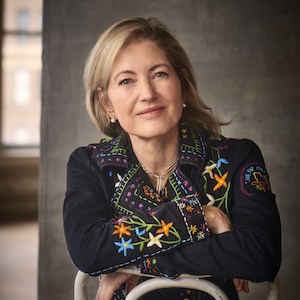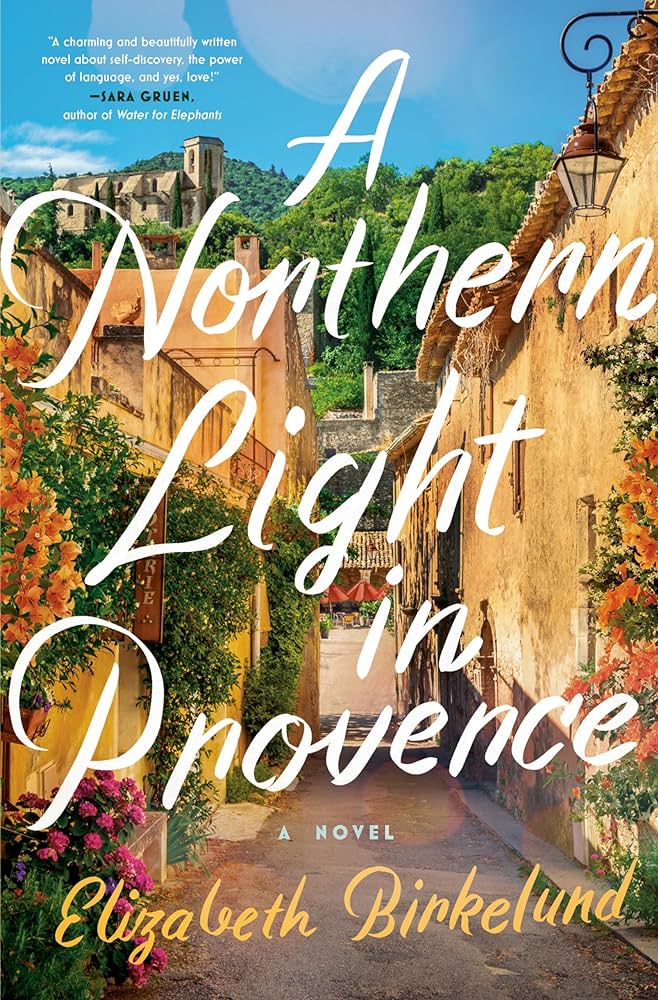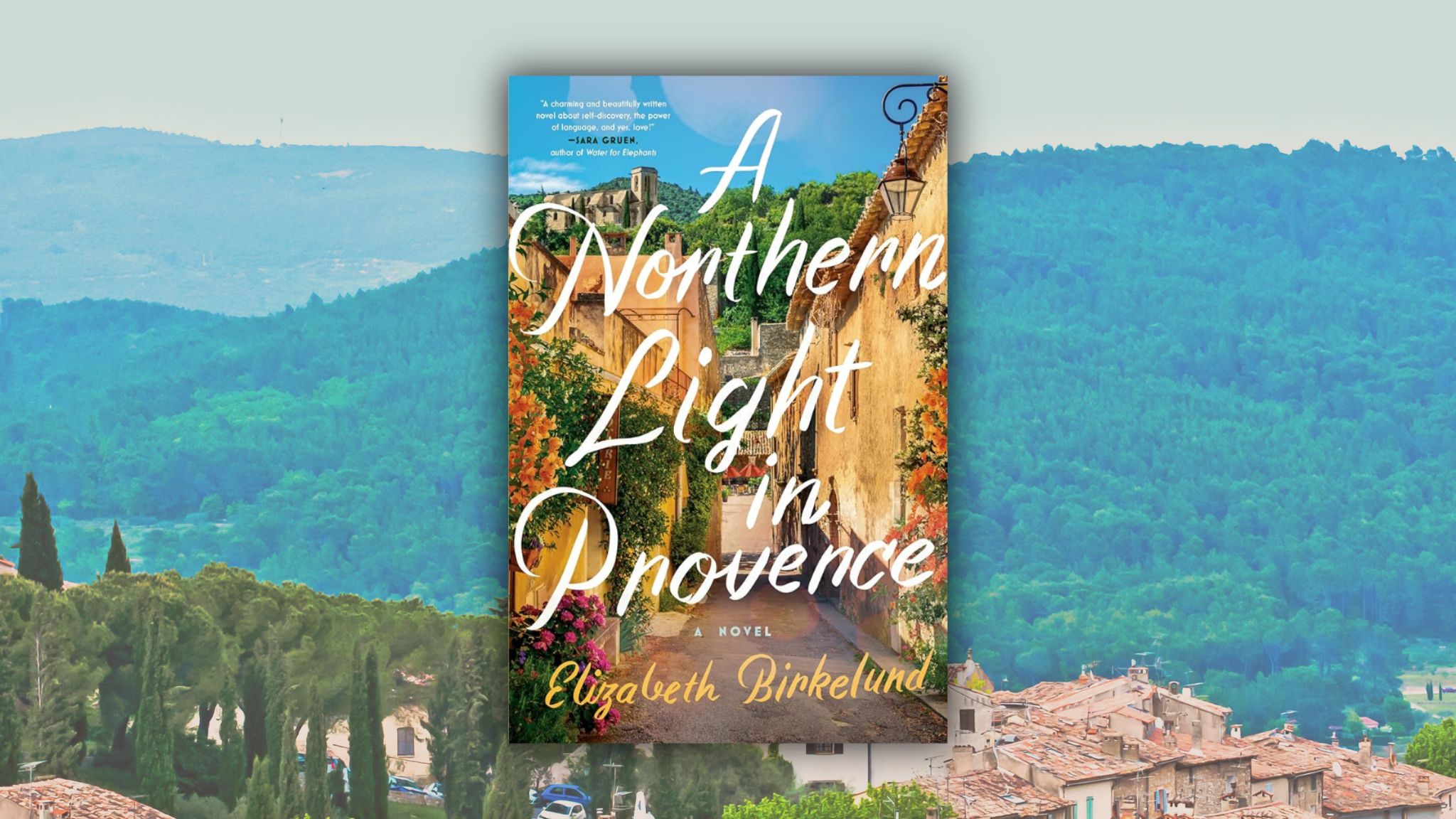A Northern Light in Provence by Elizabeth Birkelund
In Elizabeth Birkelund’s new novel, A Northern Light in Provence (Ballantine), we have an enticing love story that encompasses many layers. The locales are disparate, one is icy Greenland and the other is the mountains of Provence. Shadowing the lovers is how they have been formed by place and experience. As theme and plot point, there is a tension among family members and ghosts of the past prevail.
At the center is Ilse Erlund, a young single woman from the west coast of Greenland who is a talented translator. When she is offered an assignment of translating verses written by the last troubadour of Provence, Geoffrey la Baye, she is honored, Somewhat disenchanted with her life in Greenland and the constraints of local rituals, she readily accepts a chance to fly to France to work in real time with a legendary poet. Life there is unlike anything Ilse knows — she is thrilled, challenged and ultimately awakened. Away from home, she begins to process her brother Jann’s untimely death and is drawn to Geoffrey’s own suffering over the loss of his wife.
As she meets impressive women in Provence, Ilse begins to face her complicated issues with her mother. Not only is Geoffrey la Baye revered as the aging, charismatic and intriguing troubadour but the beauty and terrain of Provence are captivating. Life is rich enough, then Geoffrey’s son, Frey, walks onto the scene and Ilse’s newfound calm is shaken. What a read!
I had a chance to interview Elizabeth about her novel for an “in conversation” event that took place on June 3 at the Perrot Library in Old Greenwich, Connecticut.
Greenland is not such a known culture and place. You seem familiar with it. How did you come to choose it and have you been there? What about Provence, have you been there?
I chose Greenland as the home for my protagonist, Ilse Erlund, for many reasons. Since Ilse is a translator who eventually goes to Provence, I wanted her to “translate” place as well as language. Her arrival in Provence from a settlement 240 miles north of the Arctic Circle proved to be an exciting contrast. I also chose Greenland because my father’s family name at one point was Rasmussen, and Knud Rasmussen is a celebrated figure in Greenland. Part Greenlander, part Danish, Rasmussen was a first explorer to cross the Northwest Passage on dog sled. He also led expeditions into northern Greenland and wrote about the Inuit peoples. I thought it would make my father proud to know that I was writing about his Danish heritage. (Greenland is an autonomous territory of the Kingdom of Denmark.) I also chose Greenland for its staggeringly beautiful scenery. The town in which Ilse is born, Ilulissat, is the capital of Icebergs.
I wrote the first draft of my novel without going to Greenland. I relied heavily on the Internet and on verbal accounts of my explorer friends and those who had written about it. When I told my editor that I had not been to Greenland, she said, “You know you are going to Greenland.” And I said, “Yes, of course.” When I asked her if she wanted to join me, I was surprised when she said, “Okay!”
After our trip to Greenland and to the settlement where Ilse lived in a sea captain’s cottage on stilts, I changed many things in the original manuscript. In my first draft, Ilse’s home “settlement” had roads and driveways. When my editor and I arrived via ferry boat in Oqaatsut, we discovered that there are no roads in this small village. The only way residents get around is by ATV, boat, sled dog, or walking. At this point, I also discovered that of the ninety miles of roads in the whole country, only forty of them are paved! In the next draft, I converted the cars, trucks, and emergency vehicles to boats or ATVs.
You can get visuals and stories from friends and the Internet, but it’s not as easy to get the “sound” of a place from these outlets. Once in Greenland, my editor and I were astounded by the daily eruptions, the “boom!,” which was the sound of icebergs calving off glaciers and falling into the sea. Residents say the “calving” has become more frequent over the last few years, which makes climate change even more real and threatening. In the next draft, I also added the howling of hungry Greenlandic sled dogs, who are tied by chain outside the settlements. This howling occurred at sunset, just before feeding hour.
Ilse is an inviting character. We root for her from the start. Her ambivalences appear early. How was it creating such a character?
lse was a pleasure to create. From the beginning, I knew she was a translator, and translators have a difficult job. When converting one language into another, basically translating a culture, a translator can achieve only approximation. Perfection is impossible. Ile While Ilse is accustomed to ambivalences in work, she also struggles with them in her relationships.
In the beginning, Ilse is uncertain about the men in Greenland. What do you feel men represent for her?
Ilse loved her brother more than anyone in the world. When he died in a motorcycle crash, she feels betrayed, resenting him for leaving her so early. Ilse has a strong, if somewhat uncommunicative relationship with her father, but then she discovers that he is more complex than she had realized. In the beginning of the novel, Ilse realizes that her relationship with Max, her beau of six years, had been distant, “not enough,” even loveless. While at the time she had considered Max’s scant attention “enough,” given her low self-esteem, thanks to the legacy of a certain inspiring French teacher, Ilse leaves that relationship and gets up her gumption to depart Greenland, hoping that life has more to teach her.
It is interesting that Ilse has conflicts with her mother and that Frey, Geoffrey’s son, has issues with his father. Did you know how it would work out from the start for these characters?
I knew from the beginning that Ilse would have difficulty translating her version of life (devoting herself to academic work, to translation) to her mother’s version of the practical Greenlandic life. This initial conflict gave Ilse’s character definition. The Poet had similar discordant issues with his son. His son refused to accept his father’s way of living in the world, just as the Poet found it difficult to understand his son’s choices. I did not know from the outset that the Poet and his son would experience this conflict: it developed as I wrote and got to know their characters.
A place can determine behavior, possibly destiny. No spoiler here, but Ilse is drawn to the openness and loving, emotional sensation of Provence as opposed to life in Greenland. Does she believe this can provide happiness?
The importance of place, Greenland, and then Provence, is a key theme in this novel. Ilse Erlund loves the expanses of Greenland, the ever-shifting shapes of icebergs, the lichen-covered cliffs, and her family history, but when she discovers Provence, she falls head over heels. Provence represents all that she does not have, the warmth of the sun, the vibrant outdoor café life, the romantic ballads sung in the streets of the open-air market, every vegetable and fruit available, and then the charm of an elderly man poet who understands how words inform her soul.
What resonates about “Po”, Geoffrey Le Baye, for Ilse?
“Po” is the first man whom Ilse has met who truly understands her. Geoffrey LaBaye is an esteemed poet (known locally as the “treasure of Provence”), but he is also a singer and a translator. His other language is Provençal, the local dialect of his ancestors, the troubadours, noblemen in the Age of Chivalry who traveled the country crooning on the subject of love. When Ilse meets Po to translate his collected works, theirs is a meeting of souls, two people who share the love of words. He is playful, gentle, and demanding. He gives Ilse something more valuable than lessons in translation: something she’s never had before: acceptance, and celebration of who she is.
There are strong women in your novel who surprise us. Can you describe these characters and how important they are to Ilse?
There are many strong women in Ilse’s life. Ilse’s mother, “Malu” is the backbone of the family, but also extremely critical of Ilse. Her agenda for Ilse is for Ilse to scrap her ridiculous occupation as translator to do something “useful,” such as to become a school teacher, to marry, and start a family. The other strong woman in Ilse’s life plays an opposite role. Madame LaRoche is Ilse’s French teacher, represents a life steeped in romance. Unlike most residents in town who wear thickly insulated boots to trudge through the snow and sleet, Madame continues to wear high heeled leather boots to Ilse’s school. She never shows up without her red lipstick. And she wears perfume! While Ilse’s mother defies Ilse, Madame inspires.
This is a novel about love of all kinds, how it alters us. How does Ilse come to accept the importance of love in her life?
The original title of this novel was “Translating Love.” It’s difficult enough to translate one language into another, let alone to translate love. From the beginning, Ilse expresses her love for her brother and how his loss altered her. She also expresses her frustration with her ex-beau, whom she realizes never loved her.
In the beginning of the novel, Ilse accepts this version of love, the kind she witnesses in her parents, where the relationship has faded. What might have been a bright-colored fabric, is worn and bleached with overwashing. It is only when she travels out of her comfort level to Provence, that she realizes that there are different kinds of love available to her. The Poet, who writes about courtly love in the tradition of his troubadours, points her in the direction of a more romantic version of love, where it may be possible for souls to unite. And then, alors, the elderly Poet’s dashing son arrives from Paris…
About Elizabeth Birkelund:
 Elizabeth Birkelund is the author of The Runaway Wife and The Dressmaker. Her novel, A Northern Light in Provence, is out now.
Elizabeth Birkelund is the author of The Runaway Wife and The Dressmaker. Her novel, A Northern Light in Provence, is out now.
Prior to writing novels, Elizabeth was the personal finance columnist for Cosmopolitan magazine and a full-time freelance writer for national magazines including Glamour, Self, Victoria, Working Woman, and Institutional Investor. She has served on the boards of the National Humanities Center and the Center for Fiction. She received a fellowship from the Virginia Center for the Creative Arts. She lives in New York City.
Photo Credit: Sigrid Estrada




